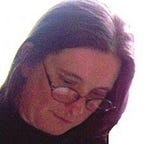What Crime Scene Tape & School Buses Have In Common
It all has to do with cones & rods
The detective flashed her credentials to the officer standing guard near the flapping yellow crime scene tape. He nodded briskly, raindrops flying off the end of his nose, and lifted the crime scene tape for her to duck under.
It seems like crime scene tape has been around forever. Both a barrier and a warning, it is a psychological tool and method of control. Did you know that in some parts of the United States, you can be arrested fined and imprisoned for crossing the tape? Can’t you just see two inmates sitting around a table in the prison cafeteria…one turns to another and says, “What are you in here for? Assault? Gunrunning?”
The second one turns, red-faced and replies, “I ducked under police tape…”
Seriously though, the more people there are wandering around a crime scene, the more contaminated that scene will get, according to ‘Locard’s Theory of Transfer’.
Edmond Locard was a French criminologist, perhaps the first CSI. In 1910, The French Police allowed Locard to create the first crime investigation laboratory, thereby making him the first crime scene investigator. Through his work studying crime, he said that every criminal who commits a crime leaves a trace.
“Wherever he steps, whatever he touches, whatever he leaves, even unconsciously, will serve as a silent witness against him.”
This became known as ‘Locard’s Principle’.
Put another way, when someone, criminal or not, interacts with a crime scene, even just wandering around, they take some trace away while inadvertently leaving behind some small trace of themselves. Bad for a criminal, good for the investigators. You can see how random people wandering around a crime scene can impact the investigation.
Do you know what crime scene tape and school buses have in common? High-visibility yellow can be easily seen by those who are color-blind. Because of the way light bounces off the rods and cones in our eyes, we see yellow more quickly than red. So even though you would think red would be a more commanding color for barricade tape, yellow is seen more easily and quickly by our eyes. Which is why, in 1939, school buses were mandated to all be painted the same high-visibility yellow shade.
Back to our crime scene. For investigators, crime scene tape is more useable than say, traffic cones. Tape can be tied to any structure that is pre-existing at the scene, such as a tree or picnic table. It can be taped to the side of a building, across a door, or stapled. It’s lightweight and comes in 1000 foot rolls.
And for our young rookie guarding the tape in the rain at the opening of this short piece, thankfully, crime scene tape is weatherproof. Too bad he isn’t!
Resources
Crime Museum
https://www.crimemuseum.org/crime-library/forensic-investigation/edmond-locard/
A&E: Crime Scene Tape, The Back Story
https://www.aetv.com/real-crime/crime-scene-tape-the-back-story
Want more stories like this one? Join Medium with my affiliate link and get unlimited access to all my stories! It’s $5 a month, giving you unlimited access to all my stories. That’s a better deal than a burger & fries, and far more educational.
